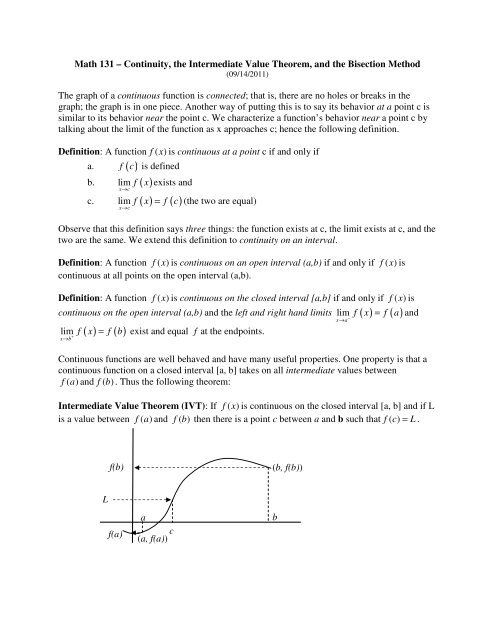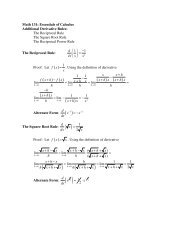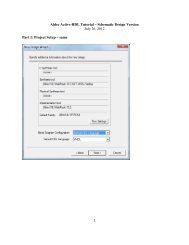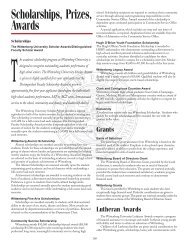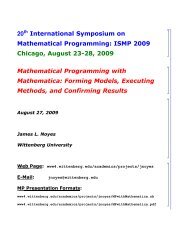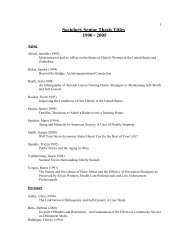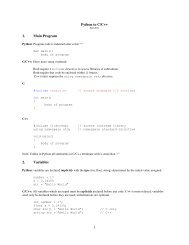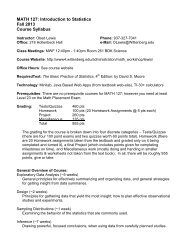Continuity, IVT and the Bisection Method
Continuity, IVT and the Bisection Method
Continuity, IVT and the Bisection Method
Create successful ePaper yourself
Turn your PDF publications into a flip-book with our unique Google optimized e-Paper software.
Math 131 – <strong>Continuity</strong>, <strong>the</strong> Intermediate Value Theorem, <strong>and</strong> <strong>the</strong> <strong>Bisection</strong> <strong>Method</strong>(09/14/2011)The graph of a continuous function is connected; that is, <strong>the</strong>re are no holes or breaks in <strong>the</strong>graph; <strong>the</strong> graph is in one piece. Ano<strong>the</strong>r way of putting this is to say its behavior at a point c issimilar to its behavior near <strong>the</strong> point c. We characterize a function’s behavior near a point c bytalking about <strong>the</strong> limit of <strong>the</strong> function as x approaches c; hence <strong>the</strong> following definition.Definition: A function f ( x)is continuous at a point c if <strong>and</strong> only ifa. f ( c ) is definedb. lim ( )f x exists <strong>and</strong>x → clim f x = f c (<strong>the</strong> two are equal)x → cc. ( ) ( )Observe that this definition says three things: <strong>the</strong> function exists at c, <strong>the</strong> limit exists at c, <strong>and</strong> <strong>the</strong>two are <strong>the</strong> same. We extend this definition to continuity on an interval.Definition: A function f ( x)is continuous on an open interval (a,b) if <strong>and</strong> only if f ( x)iscontinuous at all points on <strong>the</strong> open interval (a,b).Definition: A function f ( x)is continuous on <strong>the</strong> closed interval [a,b] if <strong>and</strong> only if f ( x)iscontinuous on <strong>the</strong> open interval (a,b) <strong>and</strong> <strong>the</strong> left <strong>and</strong> right h<strong>and</strong> limits lim f ( x) f ( a)lim+x→b( ) ( )f x = f b exist <strong>and</strong> equal f at <strong>the</strong> endpoints.−x→a= <strong>and</strong>Continuous functions are well behaved <strong>and</strong> have many useful properties. One property is that acontinuous function on a closed interval [a, b] takes on all intermediate values betweenf ( a)<strong>and</strong> f ( b ) . Thus <strong>the</strong> following <strong>the</strong>orem:Intermediate Value Theorem (<strong>IVT</strong>): If f ( x)is continuous on <strong>the</strong> closed interval [a, b] <strong>and</strong> if Lis a value between f ( a)<strong>and</strong> f ( b ) <strong>the</strong>n <strong>the</strong>re is a point c between a <strong>and</strong> b such that f ( c)= L .f(b)(b, f(b))Lf(a)ac(a, f(a))b
Exercises: Using your calculator fill in a table similar to that above that uses <strong>the</strong> <strong>Bisection</strong><strong>Method</strong> to find <strong>the</strong> zeros for <strong>the</strong> following functions.21. Find <strong>the</strong> zero for <strong>the</strong> function f ( x) = x − 5 which is 5 . Note that ( )f ( 3)> 0 . Use 5 iterationsf 2 < 0 <strong>and</strong>A f(A) B f(B) MidPt=(A+B)/2 f(MidPt)22. Find <strong>the</strong> zero for <strong>the</strong> function f ( x) = x − 10 which is 10 ) . Note that ( )<strong>and</strong> f ( 3.5)= 2.25 > 0 . Use 5 iterationsf 3 = − 1
34. Find <strong>the</strong> zero for <strong>the</strong> function f ( x) = x − 10 which is 3 10 . Note that ( )f ( 2.2)= 0.648 > 0 . Use five iterations.f 2 = − 2 < 0 <strong>and</strong>A f(A) B f(B) MidPt=(A+B)/2 f(MidPt)5. Find <strong>the</strong> zero for <strong>the</strong> function ( )2so-called “golden ratio”. Note that f ( 1)= −1<strong>and</strong> f ( )f x = x − x − 1 which is <strong>the</strong> value of2 = 1. Use 5 iterations1+5Φ =2A f(A) B f(B) MidPt=(A+B)/2 f(MidPt)<strong>the</strong>revised 09/14/2011


